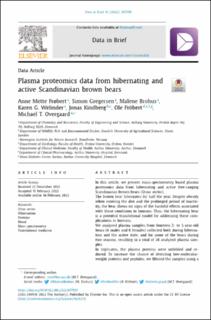Plasma proteomics data from hibernating and active Scandinavian brown bears
Fröbert, Anne Mette; Gregersen, Simon; Brohus, Malene; Welinder, Karen G.; Kindberg, Jonas; Fröbert, Ole; Overgaard, Michael T.
Peer reviewed, Journal article
Published version

Åpne
Permanent lenke
https://hdl.handle.net/11250/3010128Utgivelsesdato
2022Metadata
Vis full innførselSamlinger
- Publikasjoner fra CRIStin - NINA [2364]
- Scientific publications [1392]
Originalversjon
10.1016/j.dib.2022.107959Sammendrag
In this article, we present mass-spectrometry based plasma proteomics data from hibernating and active free-ranging Scandinavian brown bears (Ursus arctos). The brown bear hibernates for half the year. Despite obesity when entering the den and the prolonged period of inactiv- ity, the bear shows no signs of the harmful effects associated with these conditions in humans. Thus, the hibernating bear is a potential translational model for addressing these com- plications in humans. We analyzed plasma samples from fourteen 2- to 3-year-old bears (6 males and 8 females) collected both during hiberna- tion and the active state, and for some of the bears during two seasons, resulting in a total of 38 analyzed plasma sam- ples. In triplicates, the plasma proteins were unfolded and re- duced. To increase the chance of detecting low-molecular- weight proteins and peptides, we filtered the samples using a 50 K molecular weight cut-offfilter with the aim to depletelarger abundant proteins, including albumin, and thereby in- crease the depth of the analysis. The proteins in the per- meate were then tryptically digested, desalted, and analyzed with liquid chromatography-tandem mass spectrometry (LC- MS/MS). Protein identification and quantification was per- formed with the MaxQuant software searching against an Ur- sus arctos horribilis protein database. Here, we provide the raw data, a list with identified proteins in the plasma samples, and the databases applied for protein identification. Based on the provided data, differentially expressed proteins in hibernation compared to active state can be identified. These proteins may be involved in the bears’ adaptions to hi- bernation physiology and hold potential as novel therapeutic targets. Ursus arctos Hibernation Proteins Blood Mass spectrometry Translational medicine
